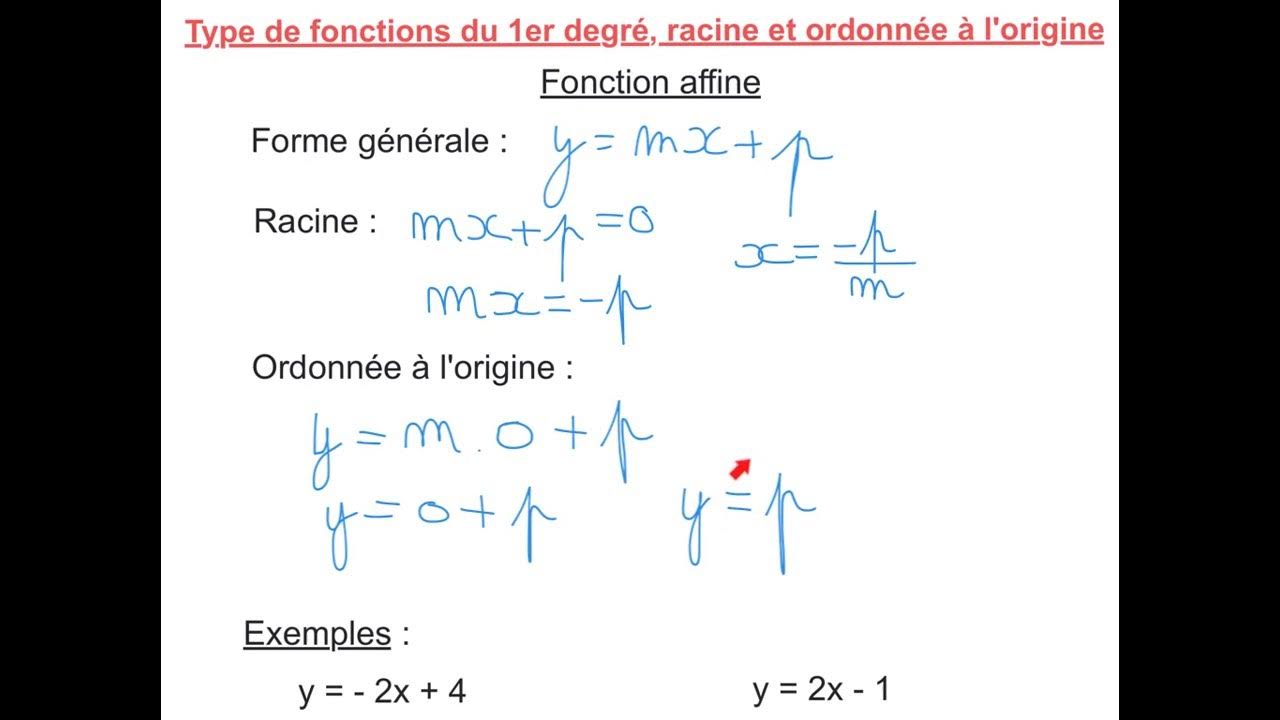FUNÇÃO AFIM - EXERCÍCIOS # 1
Summary
TLDRIn this educational video on first-degree (affine) functions, the instructor explains key concepts such as the general form of a first-degree function, how to determine values for constants like k, and the conditions for the function to be increasing. Practical examples are provided, including determining values of k in specific equations and understanding the difference between linear and affine functions. The video also covers graphing methods, emphasizing how to plot first-degree functions using points of intersection with the x and y axes. The session concludes with encouragement for viewers to engage with the content and continue learning.
Takeaways
- 😀 A first-degree (affine) function is in the form Y = Ax + B, where A cannot be zero.
- 😀 The term 'first-degree' refers to the highest power of the variable x in the function, which is 1.
- 😀 To make sure the function is in the first-degree form, ensure that the coefficient of x (A) is non-zero.
- 😀 In the example 2K - 1, we solve for k to ensure the function is first-degree: 2K must not equal 1, so k cannot be 1/2.
- 😀 To ensure a function is in the first-degree form, set expressions like k + 2 = 0, which gives k = -2.
- 😀 For a function to be increasing, the coefficient of x (A) must be positive (A > 0).
- 😀 In the inequality for an increasing function, solving 3k - 6 > 0 leads to k < 2.
- 😀 A linear function is a first-degree function where the constant term B equals zero (i.e., Y = Ax).
- 😀 To find the value of the coefficient A in a linear function, substitute given points into the equation and solve for A.
- 😀 Graphing a first-degree function involves selecting two x-values, calculating the corresponding y-values, and plotting the points to form a straight line.
Q & A
What is a first-degree function?
-A first-degree function, also known as an affine function, has the format Y = Ax + B, where A and B are constants, and A cannot be zero.
Why is a function with the form Y = Ax + B called a first-degree function?
-It is called a first-degree function because the highest power of the variable x is 1, which means it is a first-degree polynomial.
What is the role of the coefficient 'A' in a first-degree function?
-The coefficient 'A' in a first-degree function is the slope of the line. It indicates the rate of change of Y with respect to X, and it cannot be zero.
Why can't the coefficient 'A' be zero in a first-degree function?
-If the coefficient 'A' is zero, the equation would no longer be linear (it would become a constant function, Y = B), meaning there is no slope and no dependence on X.
How do you determine the value of K in the equation 2K - 1 so that it represents a first-degree function?
-For the equation 2K - 1 to be in the form of a first-degree function, K must be different from 1/2 because if K equals 1/2, the coefficient of x would be zero, making it not a first-degree function.
What condition makes a first-degree function increasing?
-A first-degree function is increasing when the coefficient 'A' is positive. This means that the slope of the line is positive, and as X increases, Y also increases.
In the equation Y = 17 - 3K - 6x, how do you determine the value of K for the function to be increasing?
-To make the function increasing, solve the inequality -3K - 6 > 0, which simplifies to K < 2. Therefore, the value of K must be less than 2.
What is the difference between a first-degree function and a linear function?
-A first-degree function has the general form Y = Ax + B, while a linear function is a special case where B = 0, meaning the function passes through the origin and can be written as Y = Ax.
How do you find the value of 'A' in a linear function that passes through the point (3, 2)?
-To find 'A', substitute the point (3, 2) into the equation Y = Ax. By substituting X = 3 and Y = 2, you get 2 = 3A. Solving for A gives A = 2/3.
What is the importance of the root of a first-degree function in graphing it?
-The root of a first-degree function is the X-value where the function intersects the X-axis (i.e., where Y = 0). This is important for graphing because it helps identify where the function crosses the axis and gives a point for the graph.
Outlines

This section is available to paid users only. Please upgrade to access this part.
Upgrade NowMindmap

This section is available to paid users only. Please upgrade to access this part.
Upgrade NowKeywords

This section is available to paid users only. Please upgrade to access this part.
Upgrade NowHighlights

This section is available to paid users only. Please upgrade to access this part.
Upgrade NowTranscripts

This section is available to paid users only. Please upgrade to access this part.
Upgrade NowBrowse More Related Video

FUNÇÃO AFIM | FUNÇÃO DO 1º GRAU | LEI DE FORMAÇÃO | AULA 1 - Professora Angela Matemática

13.2 Fonctions du 1er degré , racine et ordonnée à l'origine

VALOR NUMÉRICO DE UMA FUNÇÃO AFIM - FUNÇÃO DO 1º GRAU - AULA 2 - Professora Angela Matemática

ESTUDO DAS FUNÇÕES: FUNÇÃO AFIM - PARTE I ( AULA 3 DE 9 ) | MATEMÁTICA INTEGRAL

FUNÇÃO DO 1º GRAU: DEFINIÇÃO E GRÁFICO

FUNÇÃO DO 1º GRAU | COMO CONSTRUIR GRÁFICO | RAIZ DA FUNÇÃO
5.0 / 5 (0 votes)